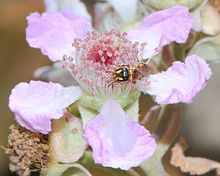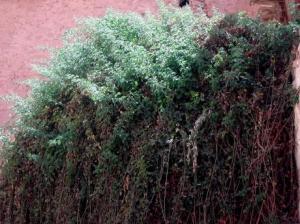By Liliana Usvat
The burning bush is an object described by the Book of Exodus as being located on Mount Horeb; according to the narrative, the bush was on fire, but was not consumed by the flames, hence the name. In the narrative, the burning bush is the location at which Moses was appointed by Yahweh (God) to lead the Israelites out of Egypt and into Canaan.
The bush is considered to be situated at St. Catherine’s Monastery, Sinai, which monastic tradition identifies as being the burning bush.
Christian hermits originally gathered at Mount Serbal, believing it to be the biblical Mount Sinai.
However, in the 4th century, under the Byzantine Empire, the monastery built there was abandoned in favour of the newer belief that Mount Saint Catherine was the Biblical Mount Sinai; a new monastery – St. Catherine’s Monastery was built at its foot, and the alleged site of the biblical burning bush was identified.
The bush growing at the spot (a bramble, scientific name Rubus sanctus), was later transplanted several yards away to a courtyard of the monastery, and its original spot was covered by a chapel dedicated to the Annunciation, with a silver star marking where the roots of the bush had come out of the ground.
The Monks at St. Catherine’s Monastery, following church tradition, believe that this bush is, in fact, the original bush seen by Moses, rather than a later replacement, and anyone entering the chapel is required to remove their shoes, just as Moses was in the biblical account
Rubus Sanctus. This species is endemic to Sinai and extremely long-lived, a fact that lends scientific credence to the site.
Medicinal Uses
Young shoots of Rubus species have been used for
- healing of wounds,
- infected insect bites and
- pimples in folk medicine for ages
The wound healing effect was comparatively evaluated with a reference ointment Madecassol. The experimental data confirmed the ethnobotanical usage of R. sanctus.
Rubus species (Rubus sp.) (Rosaceae) have been traditionally used for therapeutic purposes.
For instance, extracts of leaves and roots of this genus have been
- used for the treatment of diabetes mellitus,
- rheumatism,
- sore throat,
- hemorrhoid,
- diarrhea and
- similar enteric disorders .
- Particularly, decoction prepared from the roots of Rubus sanctus Schreber is used as herbal tea to alleviate pain and
- to heal rheumatism .
- Moreover, dried and crushed young shoots of Rubus sp. have been applied onto wounds,
- infected insect bites and
- pimples .
- anti-inflammatory activity
- extracts of R. sanctus (root and aerial part) and R. hirtus (aerial parts) showed potent antinociceptive activity,
Botanical Description

RUBUS SANCTUS
Family:- Rosaceae
Common Names:- Bramble, Blackberry.
Synonyms:- Rubus ulmifolius
Meaning:- Rubus The ancient Latin name for brambles, bramble-like.
Sanctus (L)Holy, sacred.
General description:- Very variable, thicket-forming, semi-evergreen shrub with
arching or scrambling stems, armed with stout.prickles, hairy or n
Leaves:- Hand-like with 3-5 elliptical to oval, toothed leaflets, dark green above
but whitish hairy beneath.
Flowers:- Pink or white, 20-32mm, borne in large prickly panicles. Corolla with
5 free petals, with numerous stamens.
Fruit:- (Blackberry) red at first, purplish-black when ripe, edible.
Habitat:- Woodland, thickets, hedgerows, fields, banks and rocky places
Distribution:- Widespread and common throughout the Mediterranean.
Widespread and common on Crete.
Flowering time:- June-Oct.
Propagation
- Seed – requires stratification and is best sown in early autumn in a cold frame. Stored seed requires one month stratification at about 3°c and is best sown as early as possible in the year. Prick out the seedlings when they are large enough to handle and grow on in a cold frame. Plant them out into their permanent positions in late spring of the following year.
- Cuttings of half-ripe wood, July/August in a frame. Tip layering in July. Plant out in autumn.
- Division in early spring or just before leaf-fall in the autumn
Blog 102 -365
Related articles
- Burning bush (wanderingcows.wordpress.com)
- The Treasure Trove of Religious Icons at St. Catherine’s Monastery (travelscapism.wordpress.com)
- St. Helena the Builder (yallatoursblog.com)
- Rare Storm Dumps Snow On Jerusalem, Egypt, Lebanon And Syria (fggam.org)
- In Egypt, A Distant War Keeps Tourists Away from South Sinai (world.time.com)
- Cyprus Foreign Ministry issues travel advice for Egypt (famagusta-gazette.com)
- The Unburnt Bush (optimismofcolor.com)
- Torah Portion #13 Sh’mot (Names) Exodus 1:1-6:1 (targettorah.com)
- Dictamnus – The Real Burning Bush (funflowerfacts.com)







